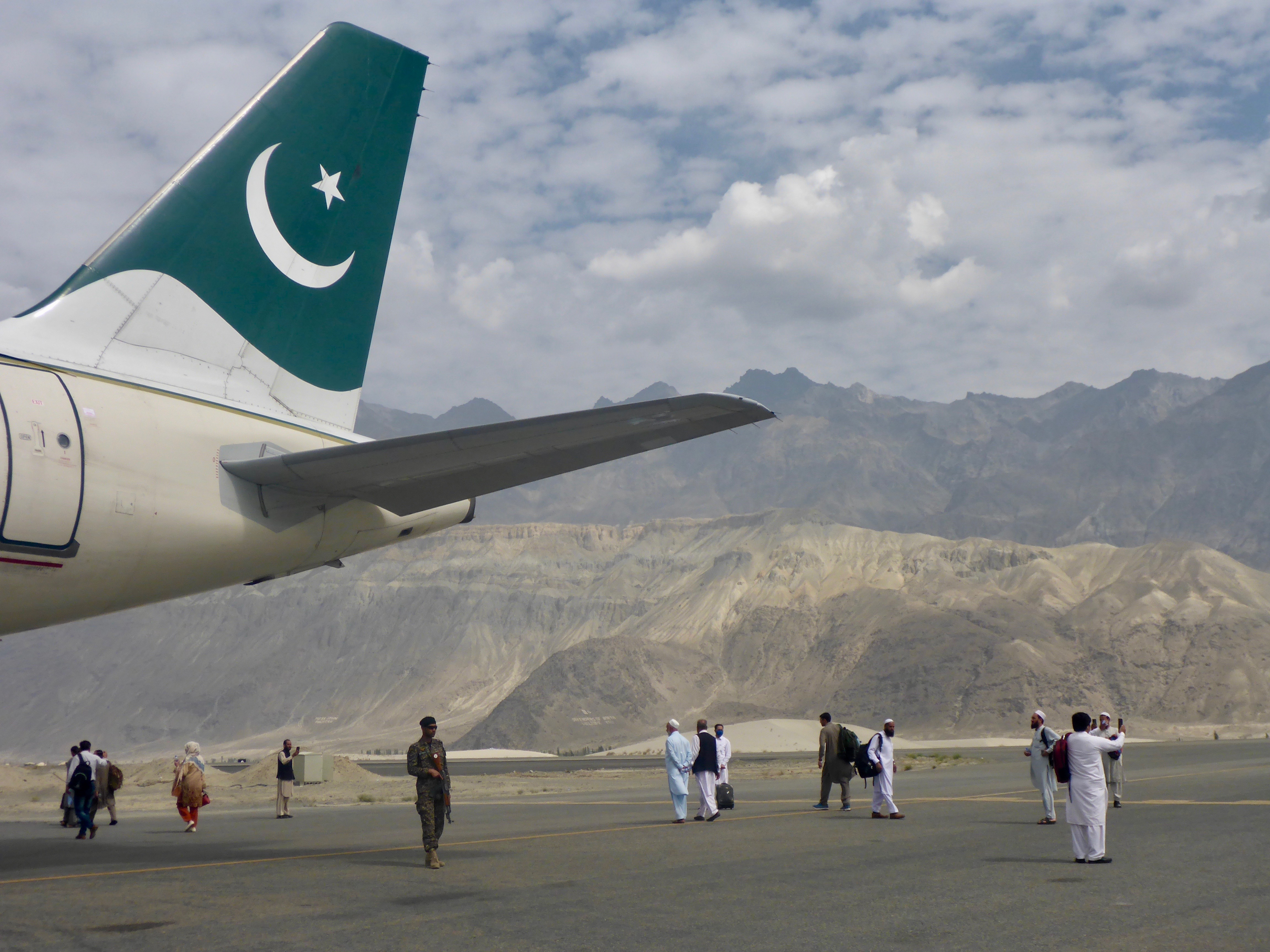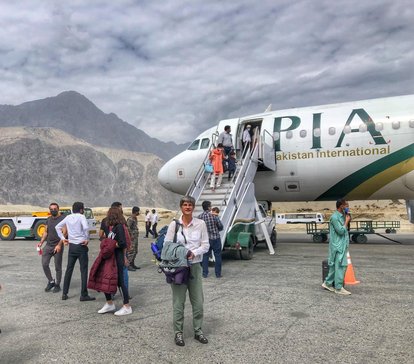Pakistan
Wings of Loss: A stock-take on PIA privatisation

BurjiLa Trek Skardu Airport Ankunft Pakistan International Airlines (PIA)
© Birgit LammThe wings of the loss, shedding debt and enhanced liabilities, a significant financial strain for the government of Pakistan for two decades, are all set to get privatised. We are talking about the planned privatisation of Pakistan International Airlines Corporation Limited (PIACL or PIA).
(PIA is an international airline which is the government-owned flag carrier of Pakistan)
The Government of Pakistan has approved a restructuring plan before the privatisation, a process which started during the caretaker regime in 2023. With the successful completion of the restructuring process, Pakistan’s government is actively looking for investors to sell the national flag carrier in order to ensure the long-term sustainability of the airline and to cut down on public spending.
The plan has led to the creation of two entities:
- TopCo (comprising core assets and core liabilities) and
- HoldCo (non-core assets and non-core liabilities.)
Selling a whole or a part of a national airline is an uncertain and extensive process, as it demands obtaining No-Objection Certificates (NOC) from all of the shareholders and creditors of PIA and negotiations to be made.
With the accumulated debt of PKR 830 billion[1], the government is in the final stage of selling TopCo and offering 100% (paid-up capital) shareholdings of HoldCo worth PKR 53.5 billion[2] [3] to the prospective investors and bidders.
Additionally, the restructuring process and settlement of PIACL loans involve settling of liability of PKR 202 billion to the new PIA, while remaining amount of PKR 628 billion will be transferred to holding company.[4] Moreover, the loans amounting to PKR 444 billion from both domestic and foreign institutions, along with the associated interest, will be transferred to the holding company. This includes PKR 161 billion owed to the government and PKR 267 billion to commercial banks.
However, selling a whole or a part of a national airline is an uncertain and extensive process, as it demands obtaining No-Objection Certificates (NOC) from all of the shareholders and creditors of PIACL and negotiations to be made. [5] On top of that fulfilling regulatory and legal requirements and performing financial audits, considering each of the stakeholder preference requires almost 6 months to 1 year of time for the restructuring process to accomplish.[6]
The bidding process
The bidding process is promising and shows the level of confidence of the potential investors. Eight companies have expressed their interest in PIACL privatisation, which comprises Fly Jinnah, Air Blue Limited, Habib Corporation, Shanxi CIG Limited (China), Gerry’s International Private Limited, and consortiums led by Younas Brothers Holdings, Pak Ethanol, and Blue World City. However, only six companies were pre-qualified and shortlisted by the Privatisation Commission Board, considering the technical, financial and documentary requirements. The companies include
- Fly Jinnah Limited
- Air Blue Limited
- Arif Habib Corporation Limited
- Consortium Lead by Y.B. Holdings (Private) Limited
- Consortium Lead by Pak Ethanol
- Consortium Lead by Blue World City.[7]

Skardu Airport Ankunft Pakistan International Airlines (PIA), 2021
© Birgit LammCase Study: Air India and EAL
Privatisation of national airlines has been a complex process anywhere in the world. Consider two international examples Air India and Ethiopian Airlines.
- In the case of Air India, where after multiple failed attempts to privatise it, the government finally sold back a majority stake to Tata Group, the first owner, in October 2021 for US$2.20 billion, after accumulating a loss of US$5.3 billion. The situation of PIACL is similar to Air India, as AI also struggled with debt, inefficient operations, and fierce competition from private carriers. The lesson to take from AI is that the current owner, Tata Group, considered merging AI with other airlines including AirAsia India and Vistara. Moreover, opting transformation plan - Vihaan (with a focus on restructuring and expansion) and a rebranding exercise – Vista, the airline is proving to be a formidable player in the aviation industry.
- The case of Ethiopian Airlines mirrors the challenges faced by Pakistan, which also struggles with limited technological capabilities and a low knowledge base with a low-income agricultural economy. Established with the help of Trans World Airlines, EAL built a robust foundation through phases of growth, focusing on capability development, crisis management, and modernisation. Significant investments were made in modernising its fleet, including acquiring advanced aircraft like the Boeing Dreamliner B787 and Airbus A350. EAL also pursued strategic equity investments in various African airlines, establishing hubs across the continent and forming partnerships, such as with DHL Logistics, to enhance its logistics and cargo services. This comprehensive restructuring aimed to transform EAL into a fully integrated aviation group, positioning it as a leading player in the global aviation industry. Conventional wisdom suggests that effective technological learning and catching up require the prior development of these capabilities through learning by doing and mastering international technologies. In Pakistan, fostering such capabilities could similarly drive significant advancements in economic growth and hence leading to a successful and smooth restructuring process.
What the future holds?
According to international standards, the PIACL’s figure of aircraft-to-employee ratio, which is more than 200, is significantly high, which may lead to increased operational costs for future investors, resulting in significant job losses upon privatisation and further deterioration of economic efficiency.
Despite facing several challenges including political interference, union resistance, and the need for substantial financial investment, the restructuring efforts have started to yield positive results and the next step in the process requires the Privatisation Commission to conduct a pre-qualification analysis as per the PC Ordinance 2000 rules. The government needs to be well aware of the fact that the failed bid attempt will certainly lead to additional losses for the government, as it lacks sufficient capital to absorb such losses, ultimately raising further tax-payer burden.
References
[1] https://propakistani.pk/2024/07/22/govt-speeds-up-pia-sale-framework-fi…
[2] https://www.piac.com.pk/corporate/images/Cargo/investor-information/SEC…
[3] https://tribune.com.pk/story/2460773/pia-holding-company-approves-rs268…
[4] https://propakistani.pk/2024/07/22/govt-speeds-up-pia-sale-framework-fi…
[5] https://issi.org.pk/wp-content/uploads/2024/04/IB_Salik_Apr_4_2024.pdf
[6] https://www.piac.com.pk/corporate/images/Cargo/investor-information/Fin…
[7] https://privatisation.gov.pk/NewsDetail/YmVlMTIxMDItODI0Ny00ZGRkLTk3YTg…

